
The 130th Engineer Brigade is an engineer brigade of the United States Army headquartered in Schofield Barracks, Hawaii that provides engineering support to the United States Army Pacific. The brigade specializes in combat engineering, construction, and bridging operations.

The 25th Infantry Division is a United States Army division based at Schofield Barracks in Hawaii. The division, which was activated on 1 October 1941 in Hawaii, conducts military operations primarily in the Asia-Pacific region. Its present deployment is composed of light infantry and aviation units. Tropic Lightning soldiers regularly train with other U.S. military branches to practice and maintain joint operations capabilities. The climate and terrain of the Pacific region demands Tropic Lightning soldiers be able to operate in physically demanding and harsh environments. In 2014, the division opened the Jungle Operations Training Center—the first such school in the Army since the closing of the old Jungle Warfare School at Fort Sherman, Panama Canal Zone. Joint operations and training with partner states herald a new chapter in the history of Tropic Lightning—America's Pacific Division.

The United States Indo-Pacific Command (USINDOPACOM) is the unified combatant command of the United States Armed Forces responsible for the Indo-Pacific region.

Fort Shafter is a census-designated place located in the City and County of Honolulu, Hawai‘i. It is the headquarters of the United States Army Pacific, which commands most Army forces in the Asia-Pacific region with the exception of Korea. Geographically, Fort Shafter extends up the interfluve (ridgeline) between Kalihi and Moanalua valleys, as well as onto the coastal plain at Māpunapuna. A portion of the area is also known as the Palm Circle Historic District; it is listed on the National Register of Historic Places and has been further designated as a U.S. National Historic Landmark. It is also known as Palm Circle or 100 Area.

Multi-National Corps – Iraq (MNC-I) was a formerly multinational, later U.S. only, army corps created on 15 May 2004, fighting the Iraq War. Its superior body, the Multi-National Force-Iraq (MNF-I) had replaced Combined Joint Task Force 7 on May 15, 2004. The change was made due to "concerns that had existed for some period of time, that the Combined Joint Task Force 7 headquarters was not sufficient to handle the range of military operations in Iraq, including peace support, civil military operations, and at the same time conduct strategic engagement such as talking to the sheiks and talking to the political authorities."

William H. Brandenburg Jr. was a major general in the United States Army. He last served as deputy commanding general, U.S. Army, Pacific, August 8, 2003. Prior to his last assignment, he was deputy commanding general for training and readiness, I Corps and Fort Lewis. From November 29, 2004, until December 1, 2005, he deployed to Iraq as deputy commanding general and commanding general, Task Force 134.
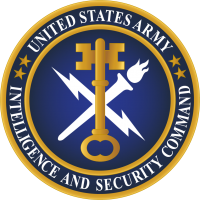
The United States Army Intelligence and Security Command (INSCOM) is a direct reporting unit that conducts intelligence, security, and information operations for United States Army commanders, partners in the Intelligence Community, and national decision-makers. INSCOM is headquartered at Fort Belvoir, Virginia.

The 196th Infantry Brigade ("Chargers"), also known as the Charger Brigade was first formed on 24 June 1921 as part of the United States Army Reserve's 98th Division with the responsibility of training soldiers.

United States Army, Japan (USARJ) is a Major Command of the United States Army. It consists of operating port facilities and a series of logistics installations throughout Honshū and Okinawa. USARJ participates actively with the Japan Ground Self-Defense Force in bilateral training exercises and the development of bilateral plans. It commands and supports United States Army assigned units, attached units, and augmentation forces and employs these forces in support of the commander. USARJ maintains and strengthens the credibility of deterrent power in the Pacific through maintenance of defense facilities, war reserves and operational project stocks. USARJ is headquartered at Camp Zama.

The 8th Military Police Brigade is a military police brigade of the United States Army based at Schofield Barracks, Hawaii. It is responsible for Army military police units within the United States Indo-Pacific Command Area of Responsibility.

United States Army Network Enterprise Technology Command (NETCOM) is a US Military unit subordinate to United States Army Cyber Command. NETCOM's mission is to operate and defend the computer networks of the United States Army. The numerical command for NETCOM was 9th Army Signal Command, though this distinction was removed on 1 October 2011. Its heritage can be traced back to the creation of the 9th Service Company in 1918. The command headquarters is at Fort Huachuca, Arizona. Major General Christopher L. Eubank assumed command in April 2022.

The United States Army Alaska was a military command of the United States Army located in the U.S. state of Alaska. A subordinate command of I Corps, USARAK was the ground element of the Alaskan Command. USARAK was headquartered at Joint Base Elmendorf-Richardson and commanded by a major general. USARAK was reflagged as the 11th Airborne Division on June 6, 2022.

The 500th Military Intelligence Brigade is a unit of the United States Army and subordinate to the U.S. Army Intelligence and Security Command. Its mission is to provide tailored, multi-disciplined intelligence and intelligence capabilities in support of USARPAC and other Commands, to defeat adversaries, promote regional stability, support partners and allies, and protect US interests. The 500th is headquartered at Schofield Barracks, Hawaii.

James L. Terry is a retired lieutenant general of the United States Army. Terry has commanded at multiple levels across the Army. Terry's last assignment was as the commanding general of United States Army Central, retiring 17 November 2015. Terry served as the last commander of V Corps before its inactivation in 2013. While commanding V Corps, he concurrently served as Commander, International Security Assistance Force Joint Command (IJC), and as deputy commander of United States Forces Afghanistan. He was the Commanding General of the 10th Mountain Division from 2009 to 2011.
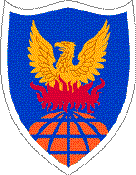
311th Signal Command Theater is the designated signal command for the Army Service Component Commands within the Pacific and Korean theaters. The staff of 311th Signal Command consists of more than 3000 active-duty soldiers, U.S. Army Reserve soldiers and Army civilians. Headquartered at Fort Shafter, Hawaii, the 311th SC(T) and its subordinate units are stationed across 16 time zones, ranging from Alaska to Korea, and from Hawaii to California.
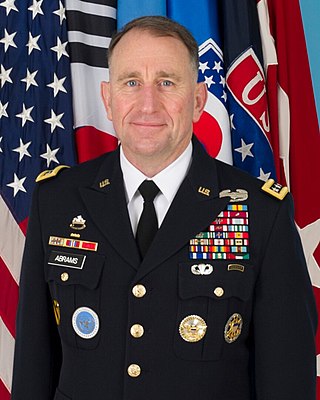
Robert Bruce Abrams is a retired four-star general in the United States Army who last served as the commander of United States Forces Korea. He concurrently served as the commander of United Nations Command and commander of R.O.K.-U.S. Combined Forces Command. He previously served as the 22nd commanding general of United States Army Forces Command from August 10, 2015 to October 17, 2018. He was a 1982 graduate of the United States Military Academy where he was commissioned as an armor officer. During his years of active service, he has held command and staff positions across the Army and joint community in Germany, the United States, Southwest Asia and South Korea. Abrams comes from a family of career military officers. His father was former Army Chief of Staff General Creighton W. Abrams Jr., and both of his elder brothers, Creighton and John, were Army general officers.
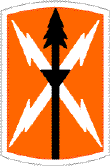
The 516th Signal Brigade is a forward based major subordinate operations and maintenance command of the 311th Signal Command(Theater). The Brigade supports the United States Army Pacific (USARPAC). The Brigade has four signal battalions, located in Alaska, Hawaii, mainland Japan, and Okinawa, Japan.

Malcolm Bradley Frost is a retired United States Army major general who last served as Commanding General, Center for Initial Military Training, United States Army, Training and Doctrine Command, Fort Eustis, VA. MG Frost most recently served as Chief of Public Affairs for the U.S. Army at the Pentagon in Washington, DC. Frost's previous assignment was Deputy Commanding General of the 82nd Airborne Division at Ft. Bragg, NC from March 2014 to March 2015. In March 2014, Frost completed his assignment as Deputy Director for Operations at the National Military Command Center, J3 the Joint Staff at the Pentagon. Prior to that, he completed an assignment as the Deputy Chief of Staff for Operations (G3/5/7) for the United States Army Pacific (USARPAC). and commanded the 2nd Stryker Brigade Combat Team, 25th Infantry Division.

Mark J. O'Neil is a retired United States Army major general who last served as the commander of U.S. Army Alaska. He previously served as the commanding officer of Delta Force from July 2, 2009 to August 2011. He has participated in numerous combat operations, such as; the wars in Iraq and Afghanistan. He assumed his final assignment on July 12, 2017, before retiring in 2019.
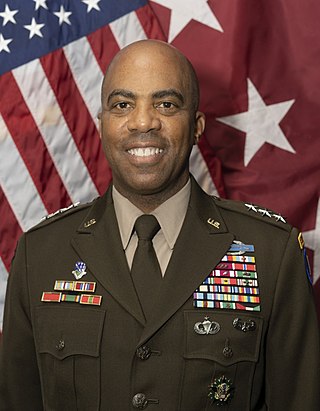
Ronald Patrick "Ron" Clark a United States Army lieutenant general who serves as the senior military assistant to the secretary of defense. He previously commanded United States Army Central from 2021 to 2022. He also served as Chief of Staff, United States Indo-Pacific Command. He previously served as the commander of the 25th Infantry Division, and, before that, as Chief of Staff, United States Army Pacific.























